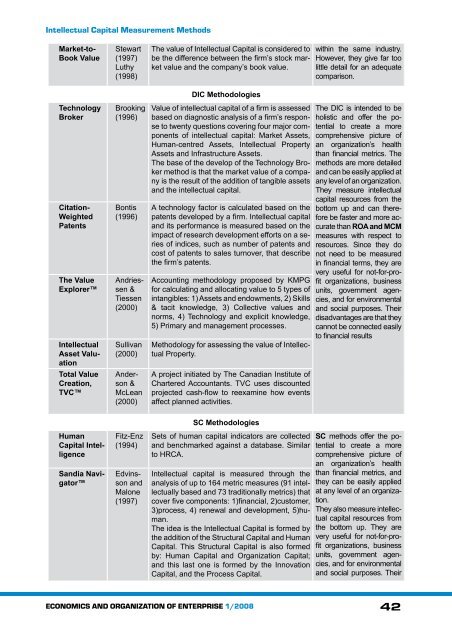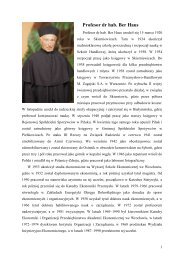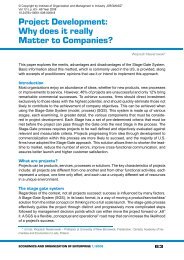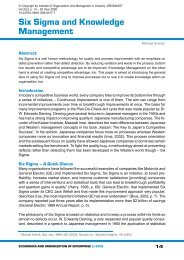Intellectual Capital Measurement Methods
Intellectual Capital Measurement Methods
Intellectual Capital Measurement Methods
Create successful ePaper yourself
Turn your PDF publications into a flip-book with our unique Google optimized e-Paper software.
<strong>Intellectual</strong> <strong>Capital</strong> <strong>Measurement</strong> <strong>Methods</strong><br />
Market-to-<br />
Book Value<br />
Technology<br />
Broker<br />
Citation-<br />
Weighted<br />
Patents<br />
The Value<br />
Explorer<br />
<strong>Intellectual</strong><br />
Asset Valuation<br />
Total Value<br />
Creation,<br />
TVC<br />
Stewart<br />
(1997)<br />
Luthy<br />
(1998)<br />
Brooking<br />
(1996)<br />
Bontis<br />
(1996)<br />
Andriessen<br />
&<br />
Tiessen<br />
(2000)<br />
Sullivan<br />
(2000)<br />
Anderson<br />
&<br />
McLean<br />
(2000)<br />
The value of <strong>Intellectual</strong> <strong>Capital</strong> is considered to<br />
be the difference between the firm’s stock market<br />
value and the company’s book value.<br />
DIC Methodologies<br />
Value of intellectual capital of a firm is assessed<br />
based on diagnostic analysis of a firm’s response<br />
to twenty questions covering four major components<br />
of intellectual capital: Market Assets,<br />
Human-centred Assets, <strong>Intellectual</strong> Property<br />
Assets and Infrastructure Assets.<br />
The base of the develop of the Technology Broker<br />
method is that the market value of a company<br />
is the result of the addition of tangible assets<br />
and the intellectual capital.<br />
A technology factor is calculated based on the<br />
patents developed by a firm. <strong>Intellectual</strong> capital<br />
and its performance is measured based on the<br />
impact of research development efforts on a series<br />
of indices, such as number of patents and<br />
cost of patents to sales turnover, that describe<br />
the firm’s patents.<br />
Accounting methodology proposed by KMPG<br />
for calculating and allocating value to 5 types of<br />
intangibles: 1) Assets and endowments, 2) Skills<br />
& tacit knowledge, 3) Collective values and<br />
norms, 4) Technology and explicit knowledge,<br />
5) Primary and management processes.<br />
Methodology for assessing the value of <strong>Intellectual</strong><br />
Property.<br />
A project initiated by The Canadian Institute of<br />
Chartered Accountants. TVC uses discounted<br />
projected cash-flow to reexamine how events<br />
affect planned activities.<br />
within the same industry.<br />
However, they give far too<br />
little detail for an adequate<br />
comparison.<br />
The DIC is intended to be<br />
holistic and offer the potential<br />
to create a more<br />
comprehensive picture of<br />
an organization’s health<br />
than financial metrics. The<br />
methods are more detailed<br />
and can be easily applied at<br />
any level of an organization.<br />
They measure intellectual<br />
capital resources from the<br />
bottom up and can therefore<br />
be faster and more accurate<br />
than ROA and MCM<br />
measures with respect to<br />
resources. Since they do<br />
not need to be measured<br />
in financial terms, they are<br />
very useful for not-for-profit<br />
organizations, business<br />
units, government agencies,<br />
and for environmental<br />
and social purposes. Their<br />
disadvantages are that they<br />
cannot be connected easily<br />
to financial results<br />
Human<br />
<strong>Capital</strong> Intelligence<br />
Fitz-Enz<br />
(1994)<br />
Sandia Navigator<br />
Edvinsson<br />
and<br />
Malone<br />
(1997)<br />
SC Methodologies<br />
Sets of human capital indicators are collected<br />
and benchmarked against a database. Similar<br />
to HRCA.<br />
<strong>Intellectual</strong> capital is measured through the<br />
analysis of up to 164 metric measures (91 intellectually<br />
based and 73 traditionally metrics) that<br />
cover five components: 1)financial, 2)customer,<br />
3)process, 4) renewal and development, 5)human.<br />
The idea is the <strong>Intellectual</strong> <strong>Capital</strong> is formed by<br />
the addition of the Structural <strong>Capital</strong> and Human<br />
<strong>Capital</strong>. This Structural <strong>Capital</strong> is also formed<br />
by: Human <strong>Capital</strong> and Organization <strong>Capital</strong>;<br />
and this last one is formed by the Innovation<br />
<strong>Capital</strong>, and the Process <strong>Capital</strong>.<br />
SC methods offer the potential<br />
to create a more<br />
comprehensive picture of<br />
an organization’s health<br />
than financial metrics, and<br />
they can be easily applied<br />
at any level of an organization.<br />
They also measure intellectual<br />
capital resources from<br />
the bottom up. They are<br />
very useful for not-for-profit<br />
organizations, business<br />
units, government agencies,<br />
and for environmental<br />
and social purposes. Their<br />
ECONOMICS AND ORGANIZATION OF ENTERPRISE 1/2008<br />
42







